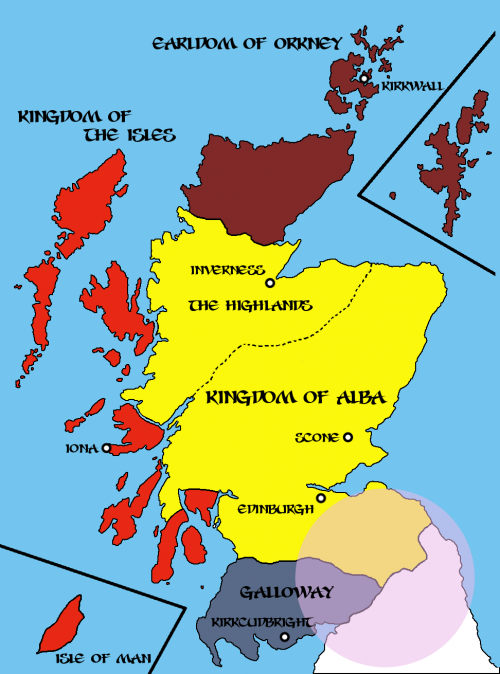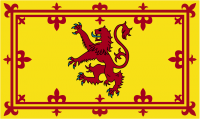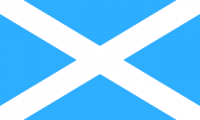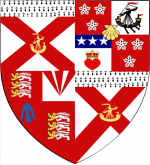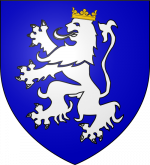Scotland
Politics
Kingdom of Alba
The largest and most powerful of the northern Kingdoms, the Kingdom of Alba would eventually consume the other Kingdoms and form modern-day Scotland. The current King of Scotland is William I, who rules these lands directly from the Royal Palace at Scone. The decades preceding the death of Henry II saw much conflict along the southern border, with the lands there changing hands between the Scottish and English many times. However, a recent and foolhardy attempt by William to reclaim Northumbria lead to his capture by the English forces, which subsequently marched north and took several Scottish castles. With no heir to the throne, William was forced to sign the Treaty of Falaise lest the line of Scottish Kings be broken by his death. This Treaty declared the King of Scotland to be a vassal to the English throne (although strictly not legally north of the Forth; it would seem that Henry had little interest in the largely barren and mountainous highlands). The death of Henry II may present an opportunity to reclaim Scotland's independence, but trouble in his own northern territories also requires King William's attention.
The Highlands
The area north of the Great Glen and River Spey is still considered a part of the Kingdom of Alba and ruled by the King of Scotland. There is, however, a definite distinction between the highlands and lowlands, socially as well as geographically. The mountainous terrain, even more formidable than that of the rest of Scotland, has bred a hardy and insular people. This area has been least affected by English culture and the lords of this land have slightly more autonomy than those in southern Scotland.
Kingdom of the Isles
Recently unified and retaken from the Norse by the warlord Somerled, the Kingdom of the Isles is now ruled by her daughter, Caitlin of Tiree. The Isles are by their very nature difficult to govern and in practice most islands act independently, governed by local Lords. The lords of the larger isles are still loyal to Caitlin, though there exist many smaller islands which are left entirely to their own devices, if they are even inhabited at all. The Kingdom as it stands now is almost an exact recreation of the Kingdom of Dál Riata as it was after the Irish Gaels first settled there. Although its popularity has waned in recent decades, Iona Abbey stands at the centre of the Kingdom as an important place of pilgrimage for devout Christians.
Earldom of Orkney
The Earldom of Orkney consists of the two northern isles of Orkney and Shetland, as well as most of Caithness and Sutherland at the northernmost tip of mainland Scotland. There are currently two Earls of Orkney, Harald Maddadsson “the Old” and Harald Eiriksson “the Young”. The Earls are subject to the William I when it comes to the mainland areas of the Earldom, but look to the King of Norway regarding the isles. After initial efforts by the Norse to take more of the Scottish mainland failed, the region has seen relative peace, with the current Earls more than content to rule their corner of the world in peace and quiet.
The Earldom of Orkney is the historical birthplace and refuge of the Orkney Sisters and the Children of Morgause.
Galloway
By strategically switching allegiance between Scotland and England throughout his reign, Alan, Lord of Galloway, has largely kept his people free from conflict. By avoiding costly battles, the relatively fertile land of Galloway is now home to one of the most powerful armies in the North. While not large enough to take on either Scotland or England single-handedly, the loyalty of Alan and his men will almost certainly decide the fate of the neighbouring lands. While Alan has historically been reluctant to engage in battle unless truly necessary, he has been making fewer and fewer public appearances in recent years and rumour has it that he lies on his deathbed. His daughter sits patiently in line to the throne, and it remains to be seen where exactly her allegiances lie.
History
The Distant Past
A thousand years ago, the Romans attempted to conquer Britain. While they succeeded in subduing the English, the people of Scotland would not be defeated so easily. The Picts remained independent and uninfluenced by any other culture until around 500 years ago when the Gaels founded the kingdom of Dál Riata in the west and St Columba brought Christianity to Scotland from France. The Fae made their way into Scotland after this, at some point after the signing of the pact of Charlemagne. Viking invaders a couple of hundred years later forced the Picts and Gaels to put aside their differences and unite under Queen Sinead mac Alpin, the first to be called monarch of all of Scotland. The Alpin line remained strong for many years until the last Alpin monarch, Malcolm II, died without naming a successor. Duncan I, the cousin and closest living relative of Malcolm, thus began a new line of monarchs which has continued ever since.
Recent History
In 1124, the crown passed to David I, who had spent much of his young life as an English Baron. He brought great change to Scotland during what became known as the Davidian revolution, bringing laws and customs more in line with those of England. Though unifying the culture, David did not seek to unify the countries; towards the end of his largely peaceful reign, David commenced a series of invasions into northern England, which eventually lead to the Treaty of Durham. The treaty formally recognised Scotland as an independent Kingdom and also gave him control of Northumbria. David is still remembered fondly by most, as one of the greatest and wisest kings to ever rule Scotland.
David outlived his children and the crown eventually passed to his granddaughter, Meredith IV. Meredith held strongly to her grandfather's ideals and was deeply religious. However, she suffered from an illness which brought her death at an early age. She was succeeded by her brother William I, who still holds the crown today. In stark contrast to Meredith, William is redheaded, headstrong, and powerfully built; he is known to some by the nickname Garbh (“the Rough”). Before his coronation, William had inherited the title of Earl of Northumbria, only to lose it again to Henry II a mere 5 years later. He dedicated a lot of effort during his reign trying to get it back. In 1174, at the Battle of Alnwick, William recklessly charged the English troops himself, shouting, “Now we shall see which of us are good knights!” He was subsequently unhorsed and captured by Henry’s troops. He was taken in chains first to Newcastle, and then to Falaise in Normandy, while Henry sent an army to take and occupy Scotland. As ransom and to regain his kingdom, William had to acknowledge Henry as his feudal superior and agree to pay for the cost of the English army's occupation of Scotland by taxing the Scots. The church of Scotland was also subjected to that of England. This he agreed to by signing the Treaty of Falaise, and was then allowed to return to Scotland.
The humiliation of the Treaty of Falaise caused a revolt in Galloway, with the Lord of Galloway declaring himself independent from the Scottish throne. Meanwhile, Somerled, originally a Scottish Countess, seized control of the Hebrides from the Norse and unified them into the Kingdom of the Isles. She has since passed the crown to her daughter, Caitlin of Tiree. The Earls of Orkney, vassals of Norway, sit quietly in the North, maintaining their hold on Caithness and the northern isles.
Life in Scotland
Geography
The landscape of Scotland can be quite different to that of England. Although similar in its flatness and relative fertility in the lowlands near the border, this quickly gives way to the hills and rugged coasts of the Highlands. Travelling North from Scone, settlements become smaller, fewer, and far between. Eventually, the mountainous regions become too inhospitable and most of the population becomes confined to the coast. The East coast is relatively welcoming, offering a fair amount of flat land to farm and settle on. The western coast consists mostly of long fingers of land separated by sea lochs. The isles themselves are particularly isolated, with rough seas often making travel difficult. The winters are also harsher in general and the ground less fertile, with little but heather clinging to the sides of the hills. People who carve out a life here are likely to be familiar with survival in the wilderness, with an abundance of moors, ancient forests, and small islands.
The border region between Scotland and England is a regularly subject to raids on both sides, and the actual location of the border can easily shift from week to week. The neutrality of Galloway provides a buffer zone in the West, but it remains to be seen how long that neutrality will last.
The Davidian Revolution
David I, father of the current King William I, brought great change to the political structure of Scotland, conforming it to many of the ideals of England. He introduced feudalism and brought Scottish Christianity in line with that of the English church. He also introduced silver coinage, promoted education and awarded generous lands to the monastic movement. Life in Scotland today is therefore not too dissimilar to life in England, at least in the larger settlements. However, the more rugged landscape and relatively sparse population make travel more difficult and promote a tendency towards smaller, more isolated communities.
Notable People
King William I
The current King of Scotland, he is strong-willed and prone to rash decisions. He is an accomplished fighter, though apparently not so much as to be able to take on the English army in a battle of poor odds. This also does not mean that he isn't foolhardy enough to try. He is still recognised as the King of Alba, but the recent humiliation of the Treaty of Falaise has eroded his public opinion.
Ermengarde de Beaumont
Wife to William by the terms of the Treaty of Falaise. While William is still the public figurehead, it seems likely that she wields at least as much power as him over matters of state. She is much more level-headed than her husband and for all his bold confidence, her quiet cunning ensures that she regularly gets her way.
Caitlin of Tiree
The current Queen of the Isles, Caitlin has held power there since the death of her mother. She is a devout Christian and has put a lot of effort into reestablishing Iona Abbey as a religious centre and place of pilgrimage. While she holds power over all the Hebrides in theory, the practical difficulties in ruling a widespread collection of islands mean that many of the smaller isles are either lawless or follow a law unto their own.
Lord Alan
The aging and well-liked ruler of Galloway. His ability to judge the flow of power in Britain has allowed him to carefully pick sides between Scotland and England and avoid costly battles. He has not made many public appearances in recent years and it seems only a matter of time before leadership is passed to his successor.
Harald the Old and Harald the Young
The joint Earls of Orkney rule over the northernmost parts of Britain. Living so far north, and with little desire for communication by either side, contact with them has been scarce.
Notable Places
Scone
Pronounced as “Skoon”, this city is the official seat of power for the King of Scotland. On the hill overlooking the town sits Scone Palace, wherein resides the Scottish throne and the Stone of Scone, ritual coronation stone for the Scottish monarchy. The great palace itself sits on a hill, overlooking the lower lands for miles around.
Iona
One of the larger islands off the West coast of Scotland. Iona Abbey was the first abbey to be built by St Columba when he arrived from the continent to spread Christianity to the Picts, it has remained an important place of pilgrimage ever since, though its popularity waned during the Norse occupation of the Hebrides. It is now home to Caitlin of Tiree, Queen of the Isles.
Inverness
The only town of any real note in the Highlands of Scotland. Most who live here consider it the northernmost point of “proper” civilisation (although those who live further south are often of the opinion that civilisation ends long before even Inverness). It sits on the river Ness which flows down from Loch Ness, the largest loch along the line of the Great Glen.
St Andrews
The small town is the center for learning and education for the north, such as it is, and an important place of pilgrimage. It is home to the largest cathedral in Scotland, which in turn houses the reliquary of St Andrew himself, patron saint of Scotland.
The Caledonian Forest
A deep and ancient forest centered on the Great Glen, home to many creatures both mundane and mysterious. A huge wealth of legends surround this place, populating it with terrible creatures, valuable treasures, druids, witches, horrors and wonders. The only legend that is common to all the settlements surrounding the forest is that no one who has sought the heart of the forest has ever returned. It is watched over by the heathen god Cernunnos, though the abundance of fae in the woods throws into dispute whether it is they or Cernunnos who truly hold dominion over this place.
Flora, Fauna, and Fae
Am Fear Liath Mor
Also known as the Greyman, this solitary fae resides atop Ben MacDhui, the highest peak in the Cairngorms. He takes great pleasure in summoning a mist to shroud the mountain and chasing travelers through it, scaring them out of their wits as he follows them with a stride four times in length that of a human. On some days, a particularly dense mist gathers, and an intense aura of fear envelopes the entire surrounding area.
Ghillie Dhu
The fae who have come to be called the Ghillie Dhu are one of the largest communities of fae in Scotland, although community is perhaps a strong word. They are spread throughout the country, living in small groups, although always appear to know what the other groups are doing, regardless of the distance between them (or at least, it has appeared so on the rare occasions when they cared to answer the questions of a curious human). The wide open spaces of the Scottish wilderness seem to suit them well in their desire for uncomplicated lives. They primarily concern themselves with their own business and do not, in general, care to associate themselves with humans. An unusually large group has congregated around Findhorn, on the East coast. Almost all of the Ghillie Dhu are dark haired and like to sleep in trees.
Fly Agaric
A very distinctive toadstool, bright red with white spots. It is found mostly in northern regions, including Norway and Sweden as well as Scotland, and is associated with coniferous forests. It is well-liked by the fae and faery creatures, being used variously as food, medicine, and even shelter for the smaller creatures. It is claimed that consuming the mushroom in a properly prepared state will grant one great insight into the ways of faery magic.
Capercaillie
The name comes from the old Gaelic and means horse of the woods, for good reason. These enormous creatures may possess the appearance of birds, but are more akin to horses in most other respects. Their feet dig the earth as they walk, like the hooves of horses, the only other animal known to have this quality. They also graze as horses do, and it is said that they may be tamed to pull carts or even be ridden. They are elusive creatures, however, and catching one is not a simple task.

